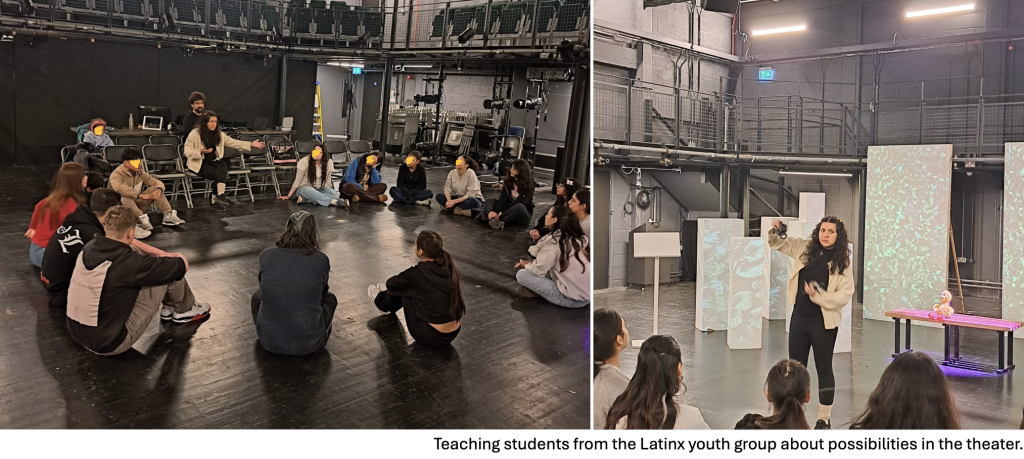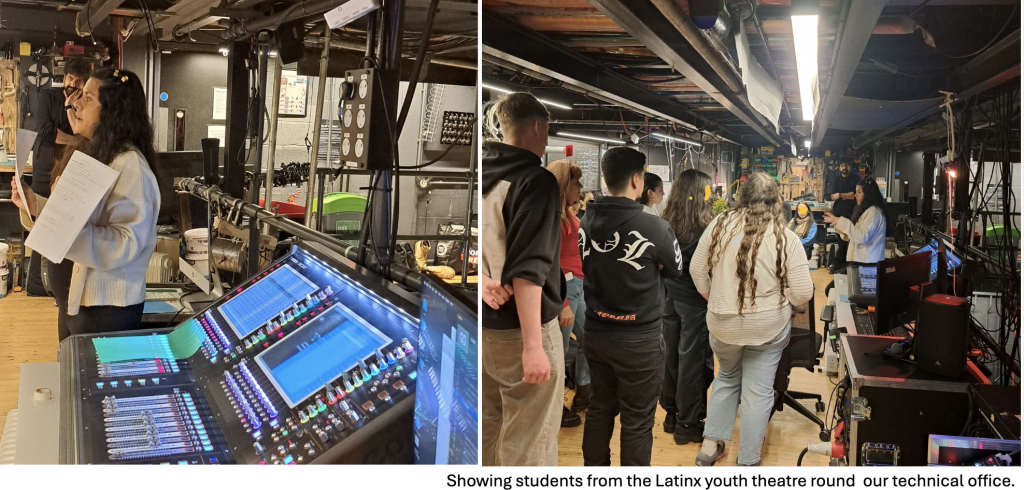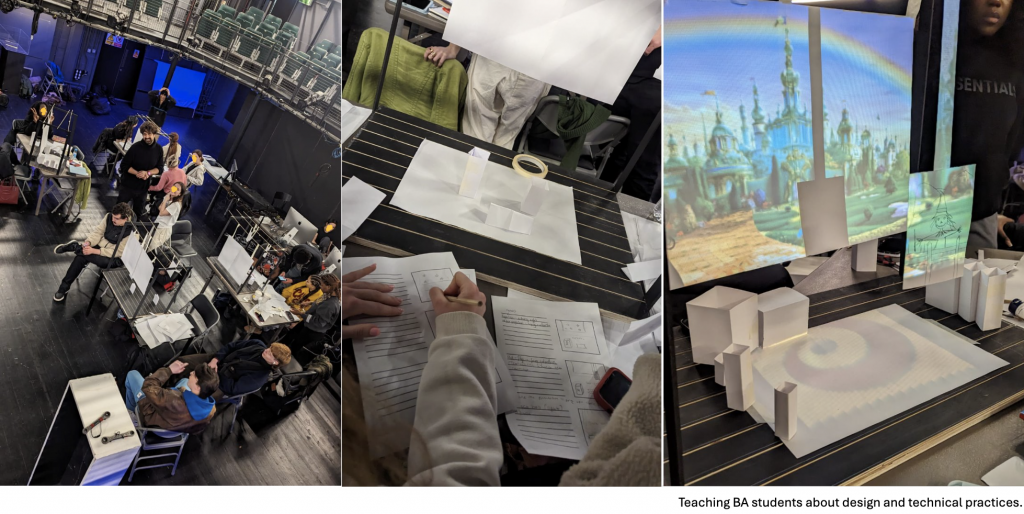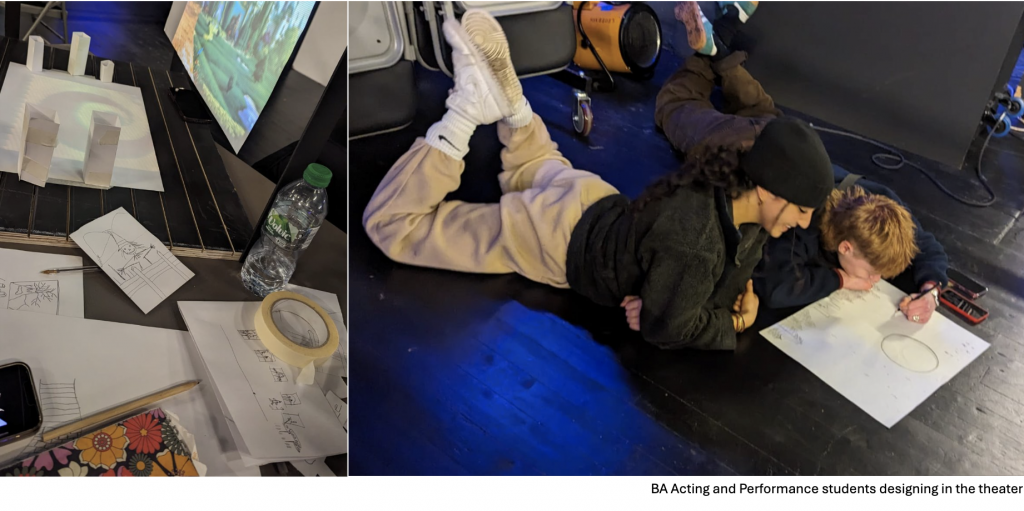Observation of Teaching Practice: Being Observed by Peer

Status and history of the learning group
The group is made up of 13 to 14 Latin American young people ranging from the ages of 14 to 20 years.
Content of the session and its context within the curriculum
The students will be given a tour of the space so they can see a working theatre close up. After the tour they will be given a talk about the different technical theater practices, giving them a little taste of all the different areas involved in building a life performance, they will be encouraged to participate and ask questions.
Aims and objectives of the learning session
To give students an introduction to the behind-the-scenes work that brings a theatrical production to life.
Encourage the students to experiment with the technical possibilities of the space
Inspire the students to further their knowledge of technical theatre.
Anticipated outcomes of the learning session
Learn about the different areas of technical theatre.
Understanding the fundamentals of making a life performance from a technical point of view.
Become familiar with the basics of lighting, sound, and projection.
Any potential difficulties or areas of concern
As there is a range of ages within the group, engagement might be an. Issue as older students might be more confident and dominate the group.
How the students will be informed of the observation
We will verbally tell the students about the observation
Any particular aspects that you wish to receive feedback on
My delivery, the pace, if it felt like I was including everyone, if the information was clear and easy to understand, if the content was boring.
Preferred time/place/medium for feedback
Written feedback, email.
Check the following:
Will your observer be able to find and access the teaching space?
Observers know the space well as well as the college campus.
Have you exchanged mobile numbers in case your observer gets lost or delayed?
Yes
Have you sent them the Observation Record with Part 1 completed?
Yes
Have you sent copies of any relevant documents (e.g. brief, slides, worksheet)?
As it is an in-person practical session no additional material is needed.

Part Two
Observer to note down observations, suggestions, and questions:
You lead an inspiring session for the young individuals, starting off with an introduction of yourself and your practice, followed by a brief discussion with the students and then an immersive tour of the Theatre. You quickly engaged the participants, and were able to maintain their attention and enthusiasm throughout your teaching, for example, the students maintained their attention to what was being introduced, (for example, I didn’t see them bring out their phones and start scrolling which could have easily happened due to the context of the session). Something that I noted enabled you to captivate their interest, was through your physical stance: i.e. from the beginning you were “at their level” sat in a circle, but also, as you led them around the theatre you briefed them as part of the group as opposed to, to the group, which lead to a non-hierarchical teaching. You also demonstrated inclusivity to the participants who didn’t speak Spanish, by translating immediately into English throughout. Similarly, in terms of physical access to the theatre, you gave options that meant that not all participants needed to use the stairs and could take different routes (i.e. the lift or easier pathways).
My thoughts on Cat’s observations
Thank you so much for observing the session and for your feedback. I am glad you felt like the session was engaging, the group was very receptive to the learning I think partly because they don’t normally have access to spaces like our theatre. I’m glad they had this opportunity and hopefully, they can come back and use the resource more.
I think this is a session we could develop more as you mentioned, the discussion part was interesting, so it would be nice to allow more space for the participants to tell us about their own experiences and knowledge of the theatre, it might also make them feel more connected to the space. It would also be interesting to hear about their experiences in performance spaces in their countries.
I really enjoyed the session it was very refreshing to have a group of young people so interested in learning, it made me realize how lucky we are at UAL to have such a great resource not just in terms of the space which is better equipped than a lot of theatres but also because we have a group of technicians with vast knowledge of the industry, so I’m very honored we were able to share it with this group of young Latinx people.
Observation of teaching practice: Observing a Peer
Status and history of the learning group
The group is made up of 13 to 14 Latin American young people ranging from the ages of 14 to 20 years. This is part of the outreach work that WCA is doing, and this is the first time we are engaging with this youth theatre.
Content of the session and its context within the curriculum
The students will have an introductory session to the theatre, from a backstage perspective, followed by some practical activities with video mapping. My role is to check in and warm up the students, and to assist fellow staff with the running of the workshop.
Aims and objectives of the learning session (for my role)
To provide a safe and effective check-in to be able to quickly understand how the students are arriving.
To facilitate a warm-up (body and voice) that responds to the needs of the group which takes into consideration information received in the check-in. (for example, their energy levels, physical tensions, concerns, etc.)
To bring the students to a state of awareness and “readiness” so that they are best placed to receive the information delivered by my peers.
To provide a safe learning environment.
Encourage the students to experiment with the technical possibilities of the space.
Inspire the students to further their knowledge of technical theatre.
Anticipated outcomes of the learning session
Reflect upon how their physical presence transformed throughout the session.
Learn about the different areas of technical theatre.
Understanding the fundamentals of making a life performance from a technical point of view.
Become familiar with the basics of lighting, sound and projection.
Any potential difficulties or areas of concern
As this is the first encounter with the students, potential difficulties may arise with regards to inclusion and access needs, since it is the first time we are meeting these individuals. For example, there maybe individuals with different physicalicalities, meaning that some exercises may need to be adapted to their range of movement, as well as being mindful of verbal instructions may need to be repeated or delivered differently.
Similarly, it is important to hold in mind that this will be the first time this group of individuals will be coming to the site, and so there may be lateness and disorientation within the space.
How the students will be informed of the observation
We will verbally tell the students about the observation and ensure that they know this is an exercise where staff are observed for feedback purposes.
Any particular aspects that you wish to receive feedback on
My delivery, the pace, if it felt like I was including everyone, and if the information was communicated clearly for all participants to understand.
Preferred time/place/medium for feedback
Written feedback, email.
Check the following:
Will your observer be able to find and access the teaching space?
Observers know the space well as well as the college campus.
Have you exchanged mobile numbers in case your observer gets lost or delayed?
Yes
Have you sent them the Observation Record with Part 1 completed?
Yes
Have you sent copies of any relevant documents (e.g. brief, slides, worksheet)?
As it is an in-person practical session no additional material is needed.
Part Two
Observer to note down observations, suggestions, and questions:
The session you led was very effective and well-received. You were very mindful of the fact that it was their first time visiting the site and made an effort to welcome them in reception and show them through to the theatre. You gave the group a clear outline of what the session was going to involve so they knew what to expect. It was really effective to have them all in a big circle for the introductions as we could all see and hear each other. You also talked in both English and Spanish and encouraged them to use the language they felt more comfortable with.
By facilitating a warm-up, you really brought the energy into the room, you were good at inviting them to have agency about the activity they were participating in, and the fact that it was presented as a game made it really fun and captivating. The activity was a great way of learning everyone’s names. Which was really useful not only for the students but also for the other facilitators. This activity also created a nice rapport between participants which made the next activities and the rest of the day much more engaging.
The physical warm-up was very inclusive, and you made sure to indicate to participants to do the movements paying attention to their bodies, as well as offering alternatives so people could participate depending on their ability.
Having activities that required them to use their bodies really helped with attention as they needed to use their body and mind, and it set the tone for the rest of the session. Focusing their attention on the here and now, which made it much easier for the other facilitators to keep them engaged.
You were very present throughout the rest of the session, encouraging students to be inquisitive. I think it could be interesting to have more context of how physical activities can prepare our minds to learn, so at the beginning, you could incorporate an introduction of how movement can be used to encourage focus. I also think you could incorporate another physical activity at the end of the session to wrap up the day.
My thoughts on Paula’s Feedback.
Thank you for the observation and feedback. I am in complete agreement that I could have linked more clearly and perhaps more explicitly the importance of working with movement, physical presence and embodiment, not just for work as a performer but also with regards to learning, as you mention.
I also agree that incorporating a physical (not just verbal) check out, and or physical reflection would have added a more embodied approach to their learning. Particularly with regard to this desired outcome: “Reflect upon how their physical presence transformed throughout the session”.
Record of Observation or Review of Teaching Practice

Part 1
Session/artefact to be observed/reviewed: Design and technical practices project, session one
Size of student group: 21
Observer: John O’Reilly
Observee: Paula Rivas
Note: This record is solely for exchanging developmental feedback between colleagues. Its reflective aspect informs PgCert and Fellowship assessment, but it is not an official evaluation of teaching and is not intended for other internal or legal applications such as probation or disciplinary action.
Part One Observee to complete in brief and send to observer prior to the observation or review:
What is the context of this session/artefact within the curriculum?
This session is part one of a week-long project for third-year Acting and performance students at Wimbledon College of Arts, and it is part of their final academic unit. The purpose of the project is to give them some experience in theatre design practices from a technical standpoint as well as basic knowledge of technical theatre processes such as stage management, lighting, sound, and video projection, to better equip them for entering the theatre industry when they leave UAL.
How long have you been working with this group and in what capacity?
I have been working with this cohort since they first started at UAL in year 1. I am the production manager for Life Performance in Wimbledon, so I oversee everything that involves performing at the college. Acting and performance students are involved in performance projects from their first year so my role throughout their journey at Wimbledon is to guide them through the process involved in transforming an idea into a stage production and help them understand what is possible in the different spaces they use.
What are the intended or expected learning outcomes?
- Evaluating how to translate a theme into a visual language that tells a story.
- Understanding the fundamentals of making a storyboard and its use in live performance.
- Exploring the basics of perspective in the context of a stage.
- Understanding the fundamentals of designing a set.
- Become familiar with the basics of lighting, sound, stage management and Projection.
What are the anticipated outputs (anything students will make/do)?
The 4 different groups will each design a 5-to-8-minute audiovisual piece based on a topic, the pieces will use original content filmed or created by the students, and the different sets will be designed using only existing scenic elements from the theatre, so no waste is created. They will get familiar with different technical areas of the theatre and learn how to operate them. The project will culminate in a showcase of the different pieces.
Are there potential difficulties or specific areas of concern?
Last year we had more time to deliver this project so this year I’ve had to make the group sizes bigger and try to concise the sessions, I worry that we wont have time to cover everything and that it might feel a bit rushed.
Since the group sizes are bigger, I also worry some students won’t engage as much or there will be some conflict within the groups as they all must collaborate and agree on an idea, so I need to make sure the quieter voices are also being heard.
How will students be informed of the observation/review?
I have informed their tutor about the observation, and I will also be informing the students verbally on the day.
What would you particularly like feedback on?
The pace of the session, whether the information given was clear if it feels like enough tools are given to the students to encourage them to create something.
How will feedback be exchanged?
In writing

Part Two
Observer to note down observations, suggestions, and questions:
Space and introduction
You create an inviting space for learning – the table arrangements, the direction to students as they come in, the checking in with students around the plays they are doing. When you note the teaching observation you do it in a light way and the students register it is not about them. What works really well are the introductions which bring the students into the different aspects of the space, from the physical space which you signal through the housekeeping around safety to the schedule of the teaching and practice activities they will be doing during the week.
Learning horizon
The slides of the schedule and the topics are well organized, they help the students locate themselves, their thinking and expectations. It’s a nice horizon of learning for them. Good image selection too! They can identify with this. Great showing the learning outcomes you’re your teaching is very effective in contextualizing it made me think (thinking for myself here too) if you might spend a few minutes with the LOs (which establish learning horizons) , asking the students what “do you think of the learning outcomes?” It can be another simple way to get them to think briefly about their learning and the design of the learning – it might be worth considering
Backstory and agency
It was really useful when you filled out the learning ‘backstory’, situating the class in terms of what they may already be familiar with, and then you scaffold the timings of the session, suggesting what the students should have ready at each stage. You negotiated showing examples really well – it is also difficult, the danger that students see a template. Your narration of different possibilities around the example is excellent, then pointing out the different techniques, effects, stage design and the performance. Because you continually emphasized the process, whether it was highlighting the project mapping or talking through the different choices, options and creative possibilities, I got a sense of the agency you were giving them. Your checking in (“do you understand what you will be doing?”) is excellent and something you do continually while giving them space.
Self positioning
Some lecturers feel self-conscious in drawing attention, and lessons, from their own work or experience, but in my experience, students appreciate this storytelling, and your honesty in sharing your experience in doing concept visualization worked really well. The themes of aging and kindness were excellent. There is a practice of free-writing we use sometime, writing without a break, not censoring yourself, for 5 minutes (in your own language) that might be worth trying.
Feeling and sound
Your connecting for them the concept of safety with door or lock was such a great example, and perhaps you could make more of how a feeling is materialized or expressed in an object in concept visualization. The background music was excellent, perhaps another teachable moment around mood, atmosphere and visualization which you did raise later in terms of suggesting to them to think of ‘audio’ moving their narrative or sequence along.
Rhythm check
I’m curious about the rhythm of your checking in with the work, you were really good at pacing that, giving the students space then listening in and some light direction and guidance. As a teacher I always find that timing difficult to judge – between being helpful and intrusive. The example of ‘grief’ and visualization was interesting, the meaning of the slide was open and perhaps a little bit cryptic (at least to me) which was not a bad thing at all in this when you are trying to encourage making. It was a good segue into your direction to, “Pull together the list of words, add more and create a narrative. Make a story or something that can be projected on stage, that can be visualized, think of a song that will help it come together.” The students take it in turns to read out their words. You are very effective in helping them make the transition from thinking in words to thinking in pictures when you use the white sheet and sharpies to start the exercise with them: “It might not even be a story, it could be surfaces it could be how you use the surfaces it could be conceptual, or it could be literal. Think about creating the space.”
Challenging stories
On one of the tables exploring ageing, a student says, “let’s look at fragility” and there’s discussion and working out this idea, possibly using different mediums, “what are we afraid of in aging skin?” You suggest that maybe we should think of “aging as a transformation rather than decay.” Later on, you also suggest that maybe thinking about aging in terms of celebration, which also may have cultural resonances. It is really valuable to notice one positionality, and there may be an opportunity to introduce this a little more, offering different ways into the topic.
Thought whispering
In general, you have a gentle and encouraging approach to helping them to extend their thinking – it is a pedagogy of the creative process, it feels like the pedagogy is from someone whose professional practice has involved collaboration, and non-conventional kinds of leadership in a creative process. When a student begins to talk, think out loud, in effect it’s a monologue and you are skilled good at translating this monologue into a question, being a ‘thought-whisperer’. When you gently surface the question behind this stream of consciousness, the student feels less self-conscious in his thinking-out-loud – ‘thinking-out-loud’ is also part of our creative practice, it is important as a teacher to shape this for the speaker and the wider group, which you do with care and skill.
Summary
The most striking element of this was how well you scaffolded the different kinds of conceptual and imaginative thinking the students were required to do. I imagine some of this is due to successful planning. Taking all this (1D?) and 2 D thinking and getting them to think again may have been a challenged but your teaching skill (navigations and materials) really supported their creative learning. In terms of further reading, you might find The Reflective Practitioner by Donal Schon worth a look. It’s a standard but also still interesting on how practitioners understand learning moments in practice, useful for thinking about practice pedagogies. Also, Anita Sinner (2022) ‘Speculative steps with story shoes: Object itineraries as sensual a-r-tography’, Educational Philosophy and Theory, 54:5, is fun around objects and artefacts in its-based pedagogy.
Part Three
Observee to reflect on the observer’s comments and describe how they will act on the feedback exchanged:
Thank you for the observation and feedback, the space lends itself to be a place for creating and I’m glad you enjoyed the session and got to see our beautiful theatre.
I agree that I need to spend a bit longer discussing with the students the learning outcomes so that they can reflect on what they will be learning and bring up any questions. It would also be an opportunity for them to voice what they want to learn, which I could then incorporate into the session.
I also agree that getting them to do some free writing, would be a really nice progression from them writing the list of words. It would allow them to start that process of storytelling in writing form first, which might facilitate them in translating those ideas into visuals. I also think is a great suggestion as our cohort of students is very international so it would give those whose English is not their first language an opportunity to think in their own language, which would ease their thought flow. I will incorporate more examples using images about how to create a mood as theatres are excellent vehicles for this. I will also incorporate more examples of how sound and light alone can generate a very specific feeling.
I think these sessions ask students to think about topics that can bring strong feelings to the discussion, so I am glad you felt like the students had a space to explore these experiences safely. I recognize it can be challenging to think about certain topics, so it is important to emphasize that the purpose is not to find answers or get to agreements but to share experiences and learn from the process. I also always try to create an atmosphere where I’m not the only one asking questions, but where students feel safe to question themselves, so I am pleased that came through in the session.
It’s not an easy task to ask students to translate concepts visually so their openness to try and eagerness to challenge themselves is very commendable. I will be looking at the reading you suggested to reflect on and incorporate useful practices in my teaching.